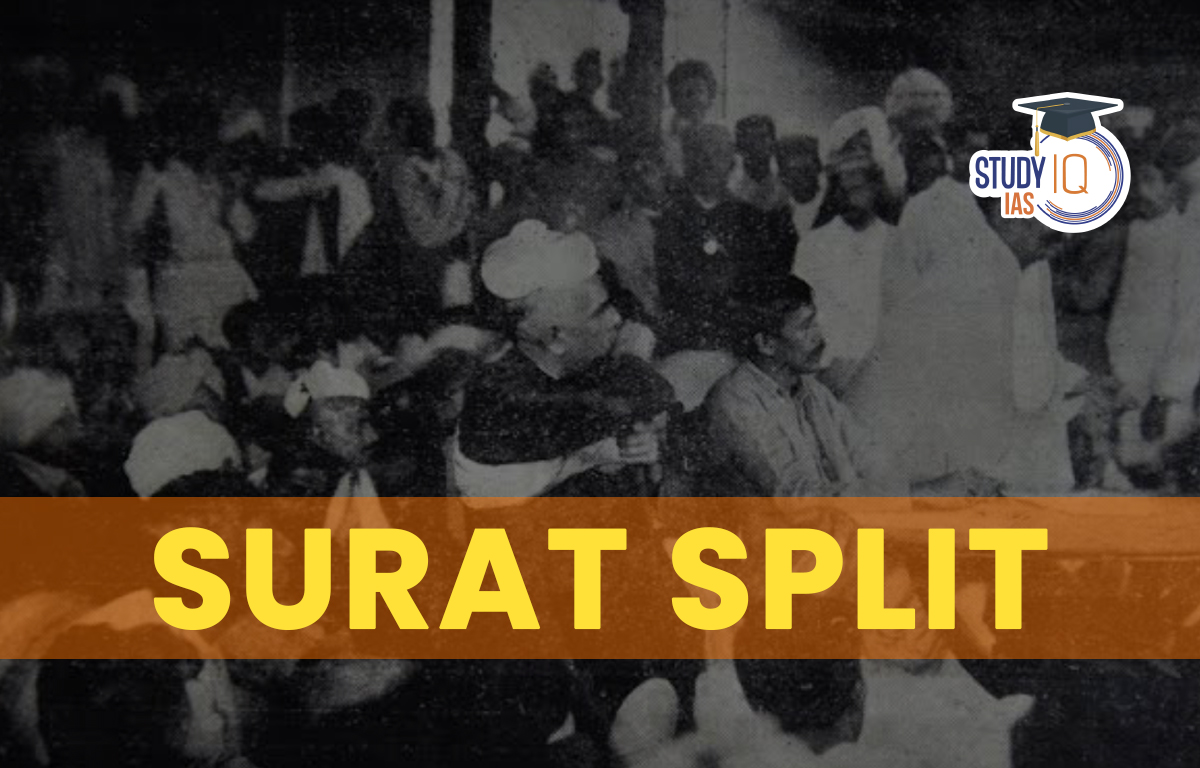Table of Contents
Surat Split
The Surat Split, which occurred in December 1907, was the climax of the conflict between the different nationalist factions. Despite Tilak and others’ objections, Rash Behari Ghosh presided over the Surat Congress gathering in 1907. Congress officials split into two groups at the Surat meeting: moderates and extremists. This division was also evident at the Banaras Congress Session (1905), where some leaders, like Tilak, proposed passive resistance in place of the moderates’ tactics. They also thought it was a good notion to boycott British products and government organisations. The Surat Split (1907) will be covered in this article and will be useful for UPSC exam preparation.
Read More: Socio-Religious Reform Movement
Surat Split History
At the Surat Session in 1907, the leaders of the Congress divided into two groups: moderates and radicals. At the Banaras Session, the division between these two factions became apparent (1905). At the conclusion of this session, Lokmanya Tilak and his followers held a separate meeting and declared the creation of the Extremist Party. However, they did choose to serve for the Indian National Congress.
The Calcutta Assembly in 1906 saw a further widening of the rift between moderates and extremists. Both parties put forth presidential nominees, but Dadabhai Naoroji was chosen as a middle ground by both. Additionally, the extremists were effective in getting a resolution passed that emphasised the swadeshi, boycott, and national education tenets.
But at the Surat Session in 1907, the Moderators were adamant about undoing what had happened at the Calcutta assembly in 1906. Extremists were equally committed to preventing the Moderates from achieving their goals. Extremists in Surat tried to promote Lala Lajpat Rai as the next president of the Congress, but moderates backed Dr. Rash Behari Ghosh. Lala Lajpat Rai averted a crisis by resigning, and Dr. Rash Behari Ghosh was elected president in his place.
Read More: Reformist Movements & Revivalist Movements
Surat Split Causes
The partition of Bengal in 1905 gave the Extremists the opportunity to publicly criticise the strategies used by the Moderates. The Partition consequently supported extremist doctrine. The Indian masses had grown weary of the moderate constitutional agitation strategy, which focused on petitioning, praying, and demonstrating; as a result, extremist tendencies that prioritised direct action against the British emerged.
For the Congress’ Surat Session, the Extremists had two primary objectives. The radicals pushed for Lala Lajpat Rai to be named INC President. The resolution from Swaraj was the second requirement. The Moderates rejected both requests.
| Indian National Movement From 1905-1918 | |
| Indian National Movement |
First World War |
| Partition of Bengal | Swadeshi Movement |
| Muslim League | Morley-Minto Reforms 1909 (Indian Council Act 1909) |
| Ghadar Movement | Komagata Maru Incident |
| Lucknow Pact | Home Rule Movement |
| Surat Split |
|
Surat Split Consequences
Following the Surat Separation, Rabindranath Tagore made vain attempts to bring the Moderates and Extremists back together. Additionally, the 1908 Allahabad convention’s adoption of resolutions to forever disqualify the Congress’s Extremist section made matters worse. In contrast to the Extremists, who wanted complete independence after the Surat Split in 1907, the Moderates called for colonial self-government.
The Morley-Minto Reforms of 1909 show that the British government was unimpressed by the moderates’ constitutional politics. The younger breed of nationalism had fallen out of favour with the Moderates. The desire for outcomes among the younger population fueled the ascent of revolutionaries. The Brits employed a divide and conquer tactic to quell militant nationalists.
In Bengal, Maharashtra, and Punjab, where terrorist activity was on the increase and the government could impose repression, extremism was primarily contained. The moderate-dominated Congress fell dormant after leaders like Bal Gangadhar Tilak were imprisoned. Muslims were given separate voting districts in 1909. Congress suffered a defeat because the INC did not include the most vocal and important constituents.
Read about: Government of India Act 1858
Surat Split and Ideological Differences
In 1905-1907, there was a great deal of public discussion and disagreement between Moderates and Extremists, even when they were working together to oppose Bengal’s partition. The radicals wanted the Swadeshi and Boycott Movement to cover the entire nation, not just Bengal. Additionally, they planned to gradually extend the foreign-goods ban to cover any association with or cooperation with the colonial government.
The Moderates strongly opposed the boycott component of the movement’s expansion to the Government and wanted to keep it within Bengal. In 1906, the debate over who would lead the Calcutta Congress came dangerously close to boiling over. The choice of Dadabhai Naoroji prevented a split. Four compromise motions on the Boycott, National Education, Swadeshi, and Self-Government demands.
The conflict between the two factions over how to interpret the four resolutions lasted the entire year of 1907. The Extremists believed that the battle for liberty had started by the end of 1907 because the public had been stirred. The bulk of them thought it was finally time to break with the Moderates.
The majority of the Moderates were similarly adamant about a split, with Pherozeshah Mehta serving as their leader. They feared that the carefully constructed Congress structure, which had taken twenty years to create, would be destroyed.
Read about: Rowlatt Act
Surat Split End Result
The Surat Split was a result of British strategy to divide and rule. The British thought they had taken over control of the INC’s affairs after a considerable amount of time. While the Extremists continued to operate independently until 1916, the Moderates continued to hold the reins of power in the House for a while longer.
Both groups subsequently came together at the Congress session in Lucknow in 1916 as a result of the efforts of the Home Rule movement’s leaders. The nation’s moderates and extremists, one representing the law and the other the impulse, were compared to its intellect and heart. Their ability to work together was necessary for the national cause to advance.
The exit of the Extremists caused the House to become paralysed for more than ten years because the Moderates were unable to accomplish very much. The Congress wasn’t revived until 1916, following the Extremists’ re-entry and the Moderates’ departure (1918). But things had changed completely by this point. As a newcomer to politics, Mohandas Karamchand Gandhi allied himself with the extremist movement. Initiating a new era in the history of modern India, he symbolized a fresh synthesis of faith and reason, law and impulse.
Read More: Sadler Commission
Surat Split UPSC
A turning point in India’s Nationalist Movement’s history was the Surat Divide. It marked a change in the government’s approach to and policy towards moderate nationalists. The Surat Divide was the primary motivating factor behind the 1909 Minto-Morley Reform. The split has left both groups significantly less strong. Liberals were abandoned by their own people while extremists confronted official repression. For UPSC Exam Preparation, read this essay to learn everything about Surat Split.
Read More: Hunter Commission


 Revival of Machilipatnam Port in Andhra ...
Revival of Machilipatnam Port in Andhra ...
 Nagari Pracharini Sabha Revival: Backgro...
Nagari Pracharini Sabha Revival: Backgro...
 Ryotwari System in India, Features, Impa...
Ryotwari System in India, Features, Impa...





















